|
|
| My Favourite Planet > English > Middle East > Turkey > Ephesus > photo gallery |
| Ephesus, Turkey |
Ephesus photo gallery 1 |
 |
 |
13 of 62 |
 |
 |
|
| |
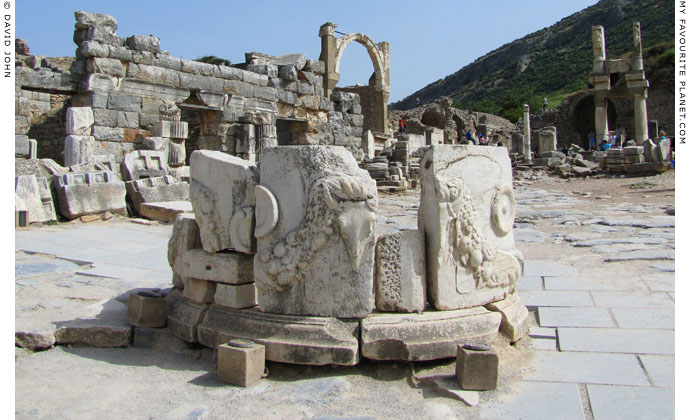
The remains of a circular monument, probably part of an altar, in the centre of Domitian Square. |
| |
Domitian Square
The large square is below the level of the west end of the Upper Agora. It acted as a junction for the two streets leading from the upper city and the Upper Agora to the east (the "Clivus Sacer" and the Magnesian Gate road), and Kuretes Street to the centre and lower city (north). It has been named after the Temple of Domitian which stood on its south side (see below). |
| |
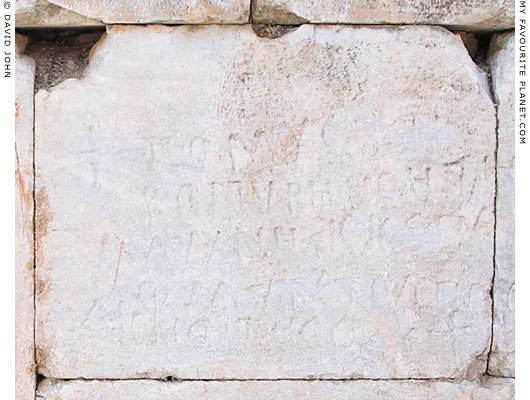
Early Christian graffiti on Domitian Square (see below). |
|
| |
| |
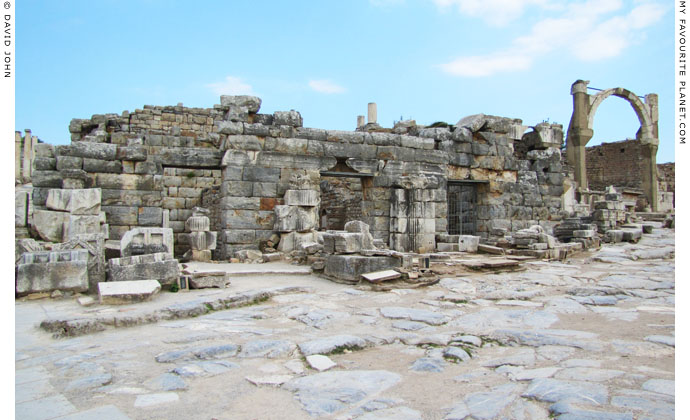
The east side of Domitian Square.
|
| A block of three large rooms, thought to have been shops, beneath the west end of the foundations of the Basilica Stoa of the Upper Agora, between the "Clivus Sacer" (left, north) and the Pollio Monument (right, see below). Archaeologists discovered the remains of a fireplace in one of the shops and dubbed it "the meatball shop". |
|
|
| |
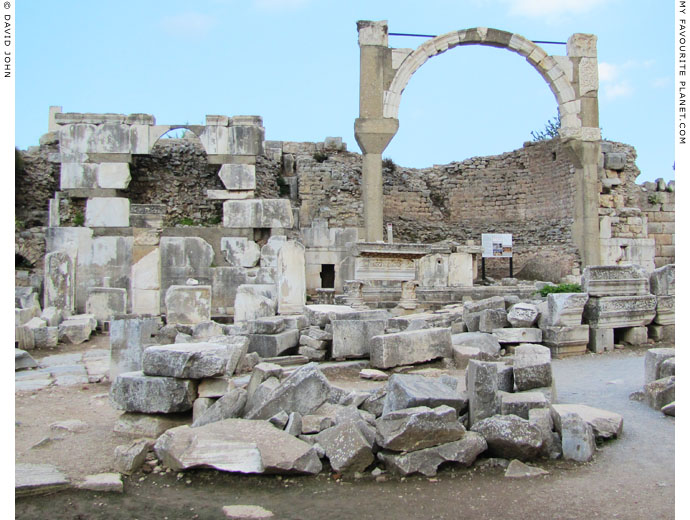
The remains of the Pollio Monument (left) and Domitian Fountain (right)
on the east side of Domitian Square.
|
The Pollio Monument was the tomb of Gaius Sextilius Pollio, who funded the building of the Basilica Stoa in the Upper Agora and an aqueduct. It was built in the first half of the 1st century AD by his stepson on land provided for it by the city. What remains here is the socle of the monument, 6.4 metres tall, 8 metres wide and 6.5 metres deep.
To the right (south) of it is the Fountain of Domitian, built in 92-93 AD, in the form of an apse. Inside stood a sculpture group depicting the Homeric story of the blinding of the Cyclops Polyphemos by Odysseus and his men (see Homer part 3). The fountain incorporated the Pollio Monument and both buildings were fronted by a facade decorated with statues. The surviving fragments of the group are now in the Ephesus Archaeological Museum, Selçuk. |
|

Gold coin of Emperor Domitian.
Palazzo Massimo alle Terme,
National Museum of Rome. |
|
| |
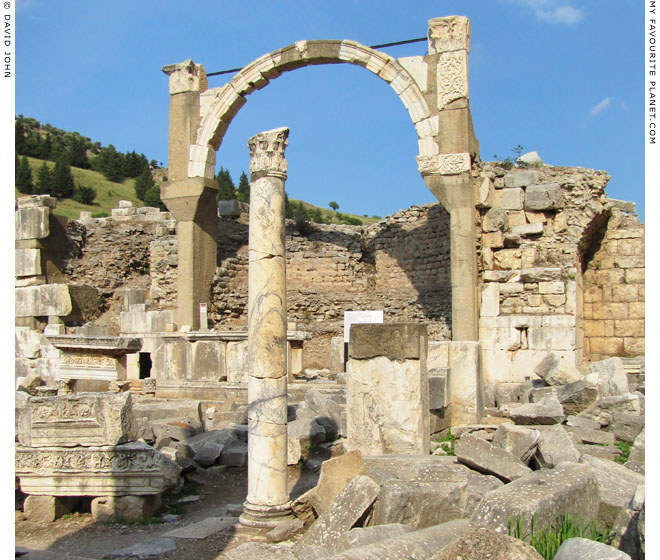
The arch of the Domitian Fountain on the east side of Domitian Square,
surrounded by architectural members including a Corthinthian column. |
| |
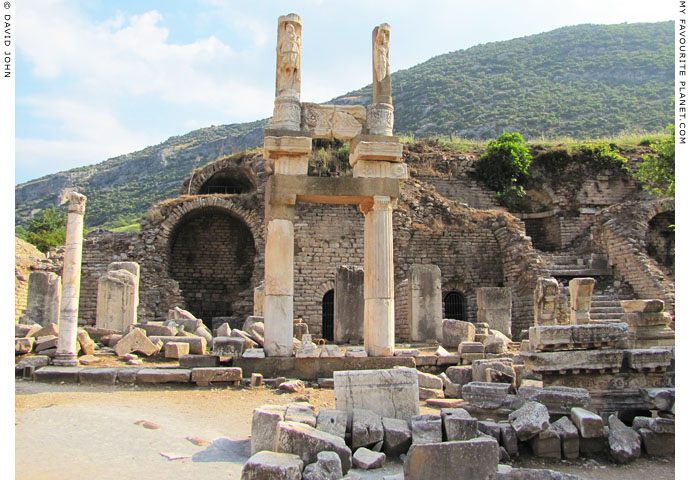
The remains of the enormous structure which supported the elevated terrace
on which the Temple of Domitian stood, on the south side of Domitian Square.
Stairs on the right lead up from the square to the sanctuary (see below).
|
The Temple of Domitian was built during his reign (81-96 AD), after he had declared himself a god and awarded Ephesus the status of Neokoros, the centre of the Imperial cult in Asia. The Ionic temple measured 34 x 24 metres at its base, had 8 columns at each end and 13 along the sides. It stood on a high terrace, 85.6 x 64.5 metres, above a building with a three-storey facade decorated with 35-40 figures of deities, constructed over a massive vaulted substructure. Two of the figures, depicting Attis and Isis, have survived (see photos below). In front (east) of the temple stood a large U-shaped altar.
A colossal acrolithic (made of wood and marble) statue of Domitian, perhaps over 7 metres tall, stood in the sanctuary, and may have been visible from the city's harbour. The surviving fragments, an enormous marble head and left arm, are now in the Ephesus Archaeological Museum in Selçuk (fragments of the right arm and legs have also been found but are not exhibited). The fact that parts of the statue were made of wood may indicate that it stood in a roofed space to avoid weathering. Some scholars believe that the statue may represent Domitian's elder brother Titus (79-81 AD), and that it was possibly part of a group of as many as five statues.
Domitian's authoritarian rule made him very unpopular, and after his assassination the Roman senate officially declared damnatio memoriae (condemnation of memory) on him: his name was erased from all public records, inscriptions, buildings and monuments; his coins were melted down and statues of him either destroyed or resculpted to represent the new emperor Nerva.
The name of his temple in Ephesus was changed to the Temple of the Sebastoi (literally, venerable ones; the Greek word for Augustus which was applied to later emperors) dedicated to the Imperial cult of the Flavian dynasty, of which Vespasian was the first emperor and Domitian the last. 13 inscriptions dedicated to the Neokoros temple by cities of Asia Minor have been discovered. The name of Domitian has been chiselled out, and in some cases replaced by that of the deified Vespasian.
The temple was completely dismantled during the Byzantine period and many of its stones reused elsewhere. The sanctuary was first excavated by the Austrian archaeologist Josef Keil in 1930. |
|
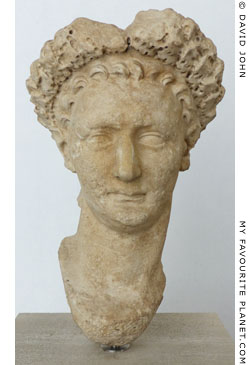
Head of a statue of Domitian
wearing a civic crown.
From Latina, 81-96 AD.
Palazzo Massimo alle Terme,
National Museum of Rome. |
|
| |
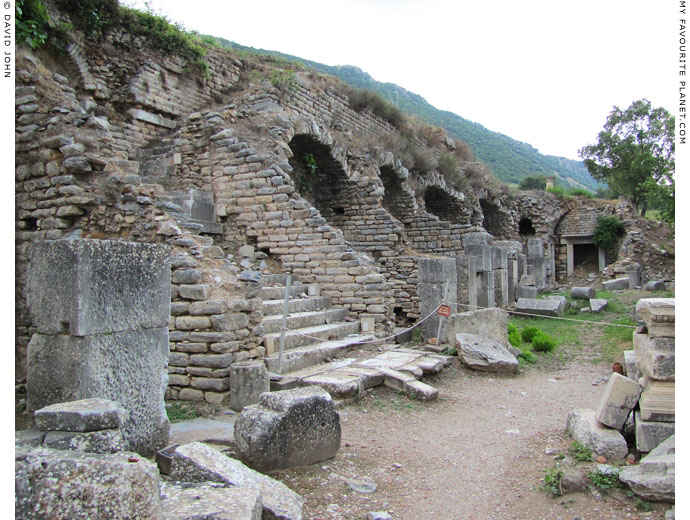
The north side of the vaulted substructure supporting the high sanctuary terrace
on which the Temple of Domitian stood, and the stairway leading up from the
south side of Domitian Square. The grass-covered terrace is not open to the public.
The Inscriptions Museum is housed in the vaults on the east side of the substructure. |
| |
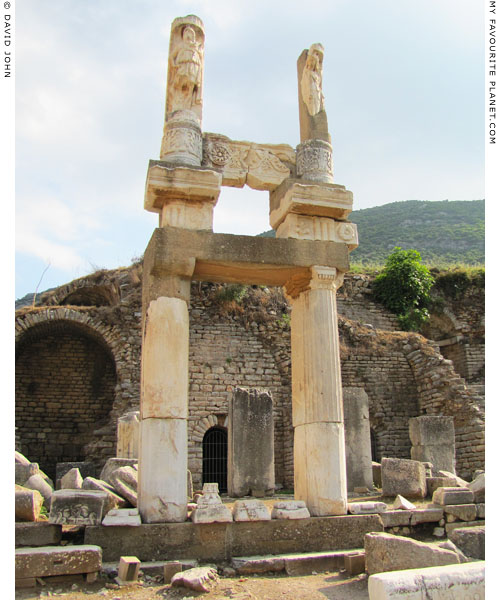
A reconstruction of part of the facade of the building which supported the
terrace of the Temple of Domitian, on the south side of Domitian Square. |
| |
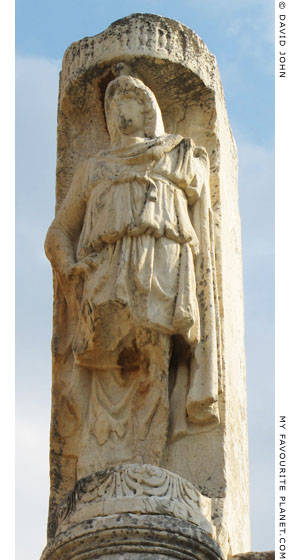 |
|
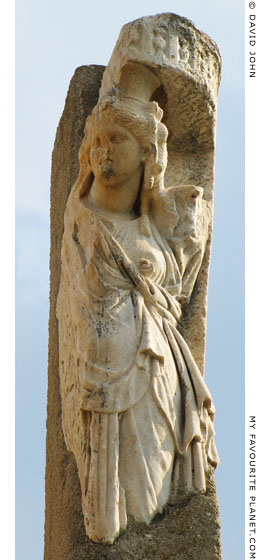 |
| Reliefs of Attis (left) and Isis (right) on the facade of the sanctuary of Domitian. |
|
| |
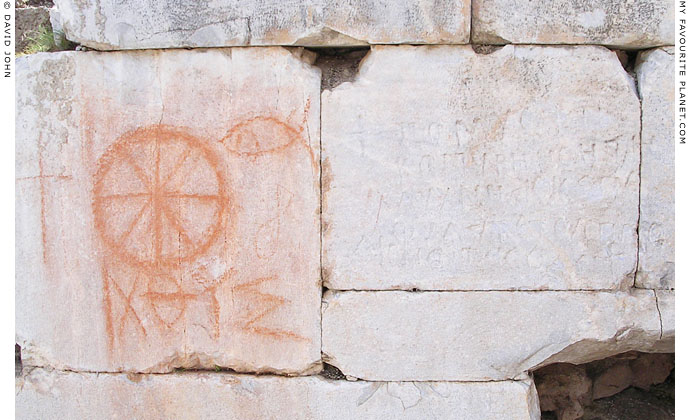
Ephesus has plenty of graffiti, ancient and recent. "ΙΧΚΘΥΣ" (ichthys, fish) is an early Christian symbol. |
Photos, articles and map: © David John,
except where otherwise specified.
Additional photos: © Konstanze Gundudis
All photos and articles are copyright protected.
Images and materials by other authors
have been attributed where applicable.
Please do not use these photos or articles without permission.
If you are interested in using any of the photos for your website,
project or publication, please get in contact.
Higher resolution versions are available on request.
Some of the information and photos in this guide to Ephesus
originally appeared in 2004 on davidjohnberlin.de. |
|
| |
 |
Visit the My Favourite Planet Group on Facebook.
Join the group, write a message or comment,
post photos and videos, start a discussion... |
|
|
| |